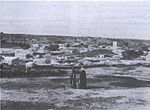Ganot
1950 establishments in IsraelAgricultural UnionMoshavimPopulated places established in 1950Populated places in Central District (Israel) ... and 1 more
Sdot Dan Regional Council
Ganot (Hebrew: גַּנּוֹת, lit. 'gardens') is a moshav in central Israel. Located near the Hiriya (now Ariel Sharon Park) it falls under the jurisdiction of Sdot Dan Regional Council. In 2019 it had a population of 587.
Excerpt from the Wikipedia article Ganot (License: CC BY-SA 3.0, Authors).Ganot
Hateena, Sdot Dan Regional Council
Geographical coordinates (GPS) Address Nearby Places Show on map
Geographical coordinates (GPS)
| Latitude | Longitude |
|---|---|
| N 32.016388888889 ° | E 34.832777777778 ° |
Address
התאנה
Hateena
6022103 Sdot Dan Regional Council
Center District, Israel
Open on Google Maps










